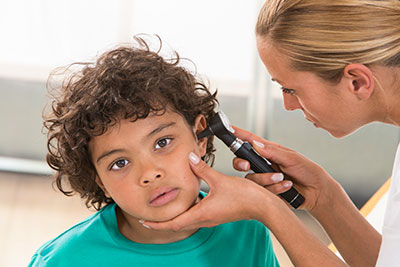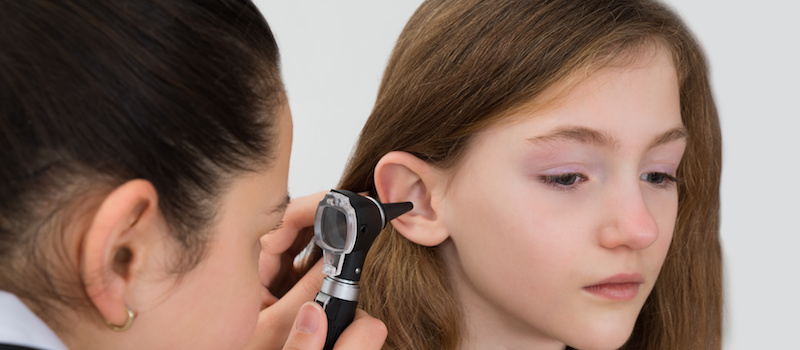If you’ve ever heard your ears “pop” when you’ve yawned or swallowed, you’ve heard your eustachian tubes opening to allow air into your ear. This essential process occurs every time we swallow and chew, but we’re blissfully unaware of it until it hurts. Ear pain and eustachian tube dysfunction is more common in children. When it becomes chronic, you may need help from a specialist.
What Are Eustachian Tubes?

Your ears can be divided into an outer, middle and inner area. The outer area is mostly visible, what we think of as our ears, and helps direct sound into our ear canal. The middle ear transfers sound from the air to the fluid-filled inner ear. The inner ear processes the vibrations in the fluid and sends the signals to our brains.
Eustachian tubes are located in the middle ear. The middle ear is filled with air and is sensitive to changes in air pressure. It also needs a steady flow of fresh air to replace what its cells absorb, and any fluid that collects in its open cavity needs to drain. Eustachian tubes function as an “air lock” mechanism that connects your ear with the back of your nose. They let air in and fluid out.
How Does Fluid Get In There?
It’s all about pressure. As cells in the middle ear absorb air, it creates a mild pressure imbalance with the air outside the ear. We normally correct this without even knowing by chewing and swallowing, letting our eustachian tubes open and air to flow in.
The problems start when our eustachian tubes are blocked or are too swollen to open. Sinus issues and upper respiratory infections are common culprits. Since air can’t get in, the negative pressure in our middle ear creates a vacuum. Fluid is pulled out of surrounding tissues and collects in the inner ear. The pressure is painful on its own, but infection often flourishes in the fluid as well.
Why Is It More Common In Children?
Children’s ears have the same basic structure as ours, but their eustachian tubes are narrower and straighter. This makes it difficult for fluid to drain. In severe cases, the fluid is so thick and sticky that it becomes its own type of blockage. This is called “glue ear.” The tubes are also shorter, making it easier for infections in the nose and throat to travel to the ear.
Additionally, children have developing immune systems and are more prone to infections. They catch more colds, causing more swelling and making it more likely fluid will collect in the ear. Once the fluid is there, it’s more likely they’ll get a secondary infection.
In other children, swelling from lymph tissue called adenoids are to blame. The adenoids are located in the upper back of the throat, above the tonsils, and swell when exposed to germs. Some children experience chronic adenoid inflammation. The swelling can cover the opening to the eustachian tubes in the throat, and infection can travel straight from the adenoids into the middle ear.
Are There Risk Factors?
Chronic eustachian tube dysfunction is most common in children between the ages of 1 and 6. Male children are the most likely to get it, and it often gets worse in the wintertime.
There are a number of other risk factors as well, including:
- Daycare attendance
- A parent who smokes
- Allergies with rhinitis
- Chronic infections
- Craniofacial malformations, especially cleft palate
- Down’s Syndrome
- Kartagener’s Syndrome, or an inability of the hairs in the ear to move, which can accompany diseases like cystic fibrosis
How Is It Treated?
Most children will outgrow eustachian tube dysfunction as their immune systems strengthen and the structure of their ears mature. In the meantime, their comfort and ability to hear are important to maintain. Hearing problems can lead to communication and learning difficulties, and chronic infection put the structures of the ear at risk for damage.
Our treatment plans are tailored to the underlying cause of your child’s eustachian tube dysfunction. For some, antihistamines, decongestants and nasal sprays to address allergies may be the best course of action. For others, exploring methods of draining the fluid could be best. Your child’s ENT will go over the options and treatment goals with you.
Don’t be surprised if your doctor doesn’t prescribe antibiotics for every infection. Unless the infection is severe or unusually persistent, most will resolve on their own. Saving antibiotics for the worst cases ensures they stay effective for when we need them the most.
Chronic ear infection and pain is common in children, but it’s always difficult to see your child suffer. If you would like to discuss your concerns with a specialist, contact Pediatric ENT of Oklahoma today.

